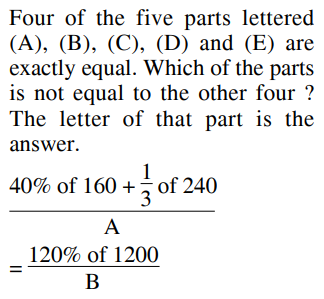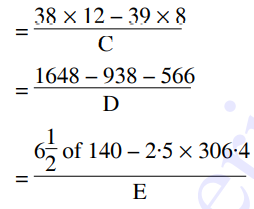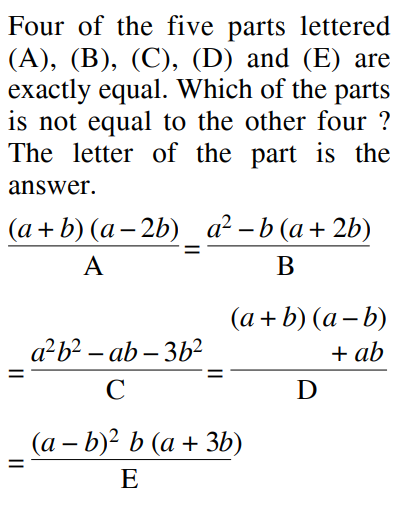Three of the four parts lettered (A) (B) ( C) and (D) are exactly equal. You have to find that part which is not equal to the other three. If all the four parts are equal, that the answer is (E).
of 56 + of 48
of 120 + of 50
of of 200
of 240 + of 25
The correct Answer is:B
Step by step video, text & image solution for Three of the four parts lettered (A) (B) ( C) and (D) are exactly equal. You have to find that part which is not equal to the other three. If all the four parts are equal, that the answer is (E). by Maths experts to help you in doubts & scoring excellent marks in Class 14 exams.
Updated on:21/07/2023Topper's Solved these Questions
Similar Questions
Knowledge Check
Three of the four parts are exactly equal which of the parts is not equal to other three?
A(62+22)÷22−17B116×2+27−266C(62×9)÷2√49Dnone of theseThree of the four parts are exactly equal. Which of the parts is not equal to other three ?
A20% of 40% of 50B60% of 50C1003% of 90Dnone of theseIn each of the following question and equation is presented in four parts with = sign in between parts. The four parts of the equation are lettered (A) (B) ( C) and (D). One of these parts in the equation may be wrong and there by may not yield the same result as the other three parts do. Find out the wrong part. If there is any. If all the four parts are correctly equated and all of them yield the same result, the answer is (E) i.e.,’No,error’.
A10% of 0⋅12B12% of 0⋅1C1% of (12×0⋅1)D100% of (120×0⋅00001)
Find the approximate value which should replace the question mark (?) in each of the following question .
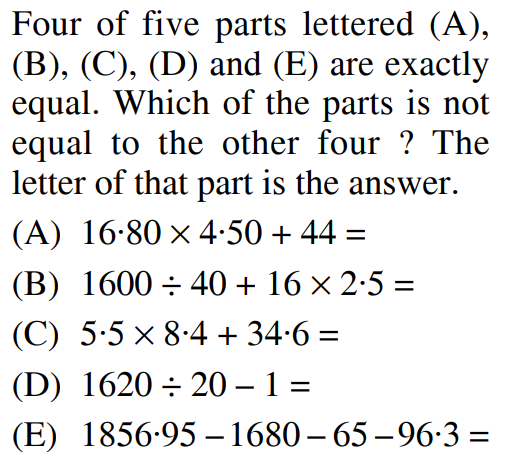
View SolutionFour of five parts lettered (A), (B),(C),(D) and (E) are exactly equal. Which of the parts is not equal to the other four ? The letter of that part is the answer....
(A)425of140+334=
(B)95%of500+50%of900=
(C)1860+380−1290=
(D)213of330+180=
(E)6.5×120+2.5×80−30
View SolutionFour parts out of the five parts lettered (A) (B) (C ) (D) and (E) in the following equation are exactly equal. Which one of the given part is not equal to the other four parts? The letter of that parts is the your answer?
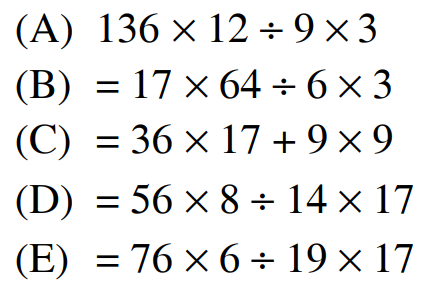
View SolutionFour of the five parts lettered (A),(B),(C ),(D) and (E ) in the following equations are exactly equal.Which of the part is not equal to the other four ? The letter of that part is the answer --
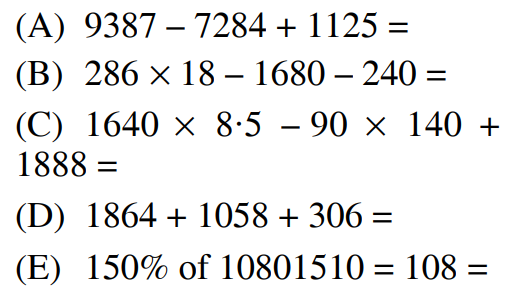
View SolutionIn each of the following question and equation is presented in four parts with = sign in between parts. The four parts of the equation are lettered (A) (B) ( C) and (D). One of these parts in the equation may be wrong and there by may not yield the same result as the other three parts do. Find out the wrong part. If there is any. If all the four parts are correctly equated and all of them yield the same result, the answer is (E) i.e.,’No,error’.
View Solution

